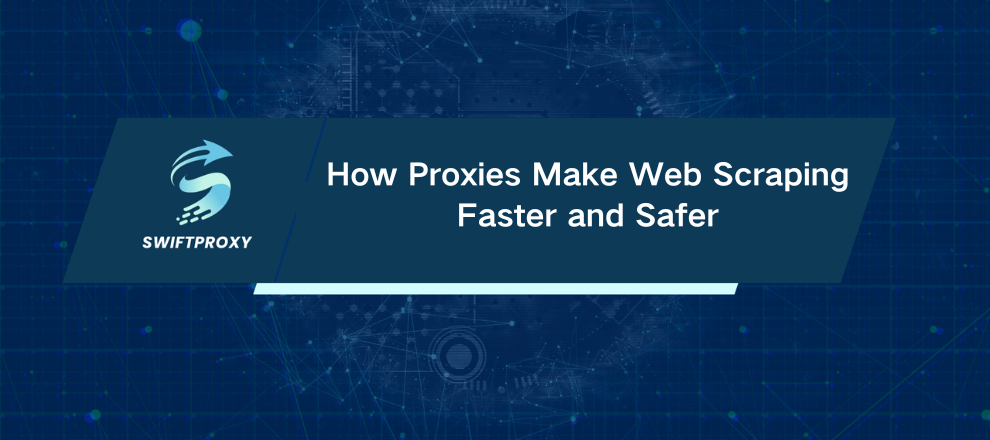How Proxies Make Web Scraping Faster and Safer

Over 90% of web data is locked behind IP restrictions and rate limits. Without the right proxies, you're essentially banging on a locked door. Proxies are your key. They transform web scraping from a tedious, error-prone process into a precise, stealthy operation. Whether you're scraping product data, market intelligence, or research info, understanding proxies can make or break your project. Let's dive deep.
Understanding Web Scraping Proxy
Think of a proxy as a middleman between your scraper and the website. It handles requests, hides your IP, and keeps your scraping operation under the radar. Here's the mechanics:
Request Routing: Instead of sending requests straight from your machine, they go through the proxy. Your IP stays hidden.
IP Hiding: The proxy uses its own IP, making it harder for websites to detect automated traffic.
Data Retrieval: The website's response comes back through the proxy to your scraper.
IP Rotation: Many advanced setups cycle through multiple proxies to mimic human browsing. This makes detection nearly impossible.
Reasons to Use Proxies for Web Scraping
Proxies aren't just a technical accessory—they're strategic tools. Here's how they give you an edge:
1. Bypass IP Blocks and Bans
IP Rotation: Switch IPs frequently to avoid detection.
Diverse IP Pool: Spread requests across different subnets. Requests appear organic.
2. Protect Anonymity and Privacy
Masking Identity: Hide your real IP, bypass geo-restrictions, and protect privacy.
Encryption: Some proxies encrypt connections, adding another layer of security.
3. Distribute Traffic to Avoid Rate Limits
Load Balancing: Spread requests across multiple proxies to prevent hitting site thresholds.
Throttling Control: Manage timing to avoid detection while maximizing efficiency.
Choosing the Right Proxy
Every proxy feature affects scraping performance. Here's what to prioritize:
Speed and Stability: Fast, stable proxies mean smoother scraping, fewer errors.
IP Rotation Features: Advanced rotation mimics real users, reducing bans.
Regional Location: Geo-targeted proxies unlock region-specific content.
Protocol Compatibility: Ensure proxies support your scraper's protocol (HTTP, HTTPS, SOCKS).
Cost Considerations: Balance budget and features. Fewer blocks save time and money.
Maintaining a Proxy Pool
Handling a large proxy pool isn't just about volume—it's about strategy:
Identify Bans: Detect blocked proxies and retire them quickly. Analyze why bans happened to avoid repetition.
Retry Errors: Automatically reroute failed requests. Keep logs for pattern analysis.
Manage Proxies: Assign tasks based on reliability and performance. Monitor continuously.
Add Delays: Randomize requests to simulate human behavior and respect rate limits.
Geographical Location: Use proxies close to your target for faster responses. Diversify locations to bypass geo-blocks.
Checking Proxies
Testing ensures proxies deliver speed, reliability, and security:
Speed: Use tools like cURL or fast.com to benchmark load times. Check timeouts and failed requests.
Reliability: High uptime and consistent responses prevent scraping interruptions.
Safety: Verify SSL certificates and ratings. Secure proxies protect sensitive data and maintain anonymity.
Regular checks are crucial. Security landscapes evolve, and a proxy that's safe today might be vulnerable tomorrow.
How Many Proxies Should You Use
The number of proxies you need depends on your scraping scale, including how many pages you target, how often you crawl them, and each site's rate limits. To minimize bans, avoid sending too many requests at once, space out requests randomly to mimic human behavior, and use advanced rate-limiting techniques.
Where to Obtain Proxies
Swiftproxy is a trusted provider for web scraping:
Global Reach: IPs in 190+ countries for geo-targeted scraping.
High Speed: Fast proxies for efficient scraping.
Anonymity: Keep your operations discreet and secure.
Setting Up a Proxy
Step-by-step for a seamless setup:
Acquire Proxies: Choose a package and generate your list (IP:Port:Username:Password).
Configure Scraper: Input proxy credentials into your scraper's settings.
Modify Scripts: In Python, use the requests library and pass proxy details in the proxies parameter.
Test: Verify setup via a site like httpbin.org/ip to confirm the IP changes.
Track and Adjust: Track performance, troubleshoot errors, tweak rotation logic.
Conclusion
Proxies are more than a tool—they're a strategic advantage. With the right setup, rotation, and monitoring, you can scrape efficiently, securely, and at scale. Armed with this knowledge, you're ready to tackle even the most guarded data sources with confidence and precision.

















































